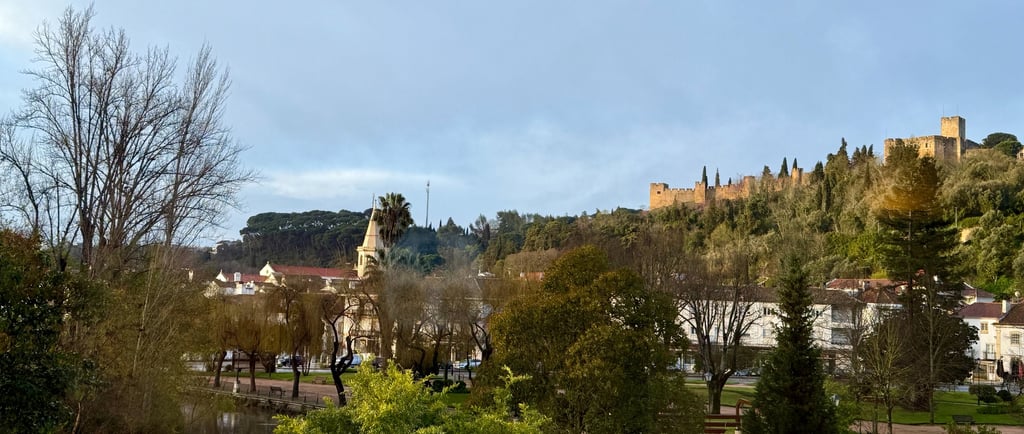March 9: In Tomar
SuperTrip 2025 blog post
2025 BLOG
3/9/20252 min read


Yesterday evening, we arrived at our swanky rest-stop hotel. I had decided on an accommodation upgrade in case we were feeling a bit sorry for ourselves. It was a good choice. Our room has locally controllable heating; a full-sized bath, for a bone-warming soak after a cold, wet day; heated towel rack for rapid clothes drying (yes, warmth is an urgent theme!).
Restored, we ventured about 300m before the rain pelted down, again. We leapt into the nearest taberna. It was (like almost everything else in Tomar) “Templar” themed: in this case “Templar” as part-Viking (drinking horns, stag-skulls, antlered light fittings), part-Thrash/Death Metal (soundtrack, glowing red LEDs, studs, chains). It was a scene. One where we had our first hot meal in 2 days and reconnected with François, who brought us a bottle of Aguardente with which we spiked our drinks (which the staff permitted). We closed the place (albeit at 8:05pm!).
Today, we enjoyed a spectacular breakfast – salty, tangy local cheeses; sweet, juicy oranges; crusty bread; quince jam, marmalade; thick coffee… Then, we climbed the hill to the castle, a (worthy) UNESCO World Heritage Site.
The Templars led much of the “Reconquista” of this part of Portugal. They ruled what they could hold, which were vast territories. We’ve been walking through “Templar land” for 2 days already. Tomar was the Spiritual Mother, Military HQ and most prestigious barracks of the Order in Portugal. The Castle preserves all of this – a sprawling complex with state-of-the-art (for 12th Century, proven in the Holy Land) defences; a chapel worthy of a Warrior Prince; the monastery/barracks with refectory, laundry, latrine block, kitchen, cellars and multilevel cloisters.
The whole complex was reimagined and perfected in the 16th Century under the patronage of, first, King Manuel I (hence, the adjective “Manueline” for the finest Renaissance carving and design) and, then, King Joao III. In between, the Templars were suppressed by Pope Clement V in the 1300s. The restraint shown by the Crown enabled the complex to pass (under the new Pope, John XXII) to the “Order of the Christ”: supposedly a successor organisation (though many would say simply the Templars rebranded and controlled by the King). The Order’s 15th Century leaders included Prince Henry the Navigator and helped drive Portuguese exploration (and colonization). The Order was finally secularized in 1789 (again by Papal Decree) and dissolved only in 1910. The Military Order of Christ is still a reward conferred for outstanding public service to Portugal.
The site is vast, but well-structured as a tour. I prayed in the chapel, whose walls are frescoed with saints, cherry-picked for a ruling, military elite: a glorious rendering of St Stephen (the first Christian martyr, complete with his bed of stones); a very “Turkish”-looking Solomon, in big hat and moustache; a very moving statue of Christ as faithful shepherd; another of a haunting crucifixion. We climbed (me very gingerly) to the top terrace and its spectacular views.
It was an enriching, absorbing experience, well worth the stop-over.
Follow our Journey at:
Email us at:
Karen's Podcast at:
© 2025. All rights reserved.
Inspired by our 2024 Camino Francais, Karen has a periodic podcast called "I sent you a bloody boat", personal thoughts on faith by a person who believes in thinking. Also, known as "The Reluctant Christian". You can listen to it on Spotify and on Apple Podcasts at:
